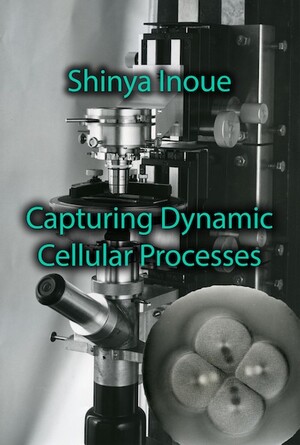Having previously inspired him in zoology classes, Katsuma Dan (who liked to be known as ‘Katy’) introduced Inoué to the possibilities presented by a different form of microscopy, using polarized light. As Inoué tells it: “One day in 1943, Katy showed me an orange colored book Die Doppelbrechung...written in 1937 by W.J. Schmidt in Giesen, Germany. In the book, Katy pointed to some photographs of 4-cell stage sea urchin eggs that Schmidt had taken through a polarizing microscope. What I saw in Schmidt’s photomicrographs were a single football shaped birefringent body (with small gaps halfway along their lengths) in each cell that was just about to divide.” (35)
Dan’s interest in the mechanisms of cell division led him to invite Inoué to his home in order to reproduce Schmidt’s experiment. Dan had proposed that in the dividing cell, the two asters are pushed apart by elongating spindle fibers. So, against the backdrop of Tokyo in the Second World War, and using sea urchins brought from the Misaki marine station and a polarizing microscope borrowed from the Geology Department, Inoue worked with Dan and his wife Jean. As Inoué recalls, “The excitement mounted in the small room, curtained with air raid shutters, as we tried to repeat W.J. Schmidt’s observations. The eggs were collected by injecting KCl solution into the sea urchin’s body cavity and then fertilize by mixing with sperm. Fifty minutes later the eggs were dividing under the polarizing microscope. But could we see the spindle shaped birefringence? Some thought maybe yes, others definitely not. A wonderfully exciting evening; but the results were inconclusive.” (3637)
Inoué and Dan would have to wait until years after the devastation of the war to resume their work. Shinya was called into military service in spring 1945, and he experienced malnutrition and the firebombing of Tokyo. Years later he challenged J. Robert Oppenheimer, asking him why the atomic bomb had not been dropped on an uninhabited island, rather than on densely-populated cities. After the end of the war, Inoué moved back to the family home, and Katy and his wife returned to their home. On 31st December, the US authorities handed the Misaki Marine Biology Station back to Toh-Dai, and Shinya and Katy could continue their work.
Inoué and Dan believed that the only way to demonstrate the role of the spindles in cell division was to examine the process of cell division in live cells. To do this, they needed to find alternative ways to produce a contrast between the spindles and the rest of the insides of the cell. They could not use traditional methods of fixing and staining, as these would entail killing the cell. The method of contrast they chose took advantage of the properties of light, and the properties possessed by the mitotic spindle.
- Shinya Inoué, Pathways of a Cell Biologist. Through Yet Another Eye. Springer: 2016
- Shinya Inoué, Collected Works Of Shinya Inoué: Microscopes, Living Cells, and Dynamic Molecules (With DVD-ROM). World Scientific Publishing Company; Har/Dvdr edition (July 18, 2008).

